Last Updated on August 27, 2021
[お茶漬け風味噌焼きおにぎり]
If there’s one thing I need to pick to represent quintessential Japanese food, it has to be onigiri (rice ball.) Miso Grilled Onigiri with Green Tea (Ochazuke Style) is a variation of the Japanese onigiri with a twist! Miso is slightly charred from grilling with a hint of sweetness from mirin. The grilled-to-perfection onigiri soaks up grassy taste of green tea. It’s different from the usual Japanese food that may be familiar with but definitely worth trying!
What’s Onigiri?
Onigiri [おにぎり] is a Japanese word for rice ball. It’s made of cooked Japanese rice seasoned with salt, shaped in triangle or circle then wrapped with nori seaweed. I eat onigiri at least three times a week so does my husband, Peter.
This handheld Japanese food is widely eaten allover in Japan. I consider onigiri to be Japanese “fast food” minus the health concern that typically associates with American fast food. We pack it for lunch, a quick snack, or a picnic. It’s tasty, satisfying, yet quick to eat to give you the energy you need.
Onigiri comes in many variety and flavors. The very basic one is called shio-musubi [塩むすび] which can be translated as salted onigiri (musubi is an another word for onigiri.) This would the best way to enjoy the taste of rice itself, salt, and nori seaweed, especially if you happen to have high quality rice, salt, and nori .
You can even make one without the nori seaweed which is what I do 95% of the time. Good quality nori can be pretty expensive here in the U.S. and this Miso Grilled Onigiri with Green Tea is made without the nori.
Miso Grilled Onigiri
This recipe is one of the popular variations of onigiri which is grilled onigiri called Yaki Onigiri [焼きおにぎり.] The process of making onigiri is the same as the typical ones. The only difference is that after shaping the onigiri, you either grill it or toast it in a toaster oven. By grilling (or toasting), it gives the charred flavor that regular onigiri doesn’t provide!
The typical flavor of yaki onigiri is either soy sauce or miso base. I personally prefer the one with miso only because I’m not really a fan of charred-flavored soy sauce. Miso has a hint of natural sweetness from koji. To enhance the sweetness of the miso, I mixed with mirin. For the extra flavor, sesame oil is mixed in the miso sauce.
You can imagine how aromatic that would be! It’s so irresistible!
Why Green Tea? Ochazuke?
You might be wondering why I use green tea in the dish. Truth is that you could certainly eat this grilled onigiri without the addition of green tea. But green tea poured over the onigiri makes it ochazuke style.
Ochazuke [お茶漬け] is a type of Japanese dish that’s composed of cooked rice with green tea poured over. Often times, dashi or hot water is used instead of tea. While the basic version is just rice and tea per se, but honestly it’s a bit bland. So the common way is to eat with some salty component such as grilled salted fish, umeboshi, seasoned nori just name a few.
That said, you can consider the salty component of this dish to be the miso sauce. When the flavor of slightly charred miso sauce, rice and green tea combined in the mouth, it has such a unique flavor.
The consistency of ochazuke in general isn’t as thick as porridge and this dish isn’t thick either. It’s so light that you can eat this for breakfast or at late night.
Ochazuke always reminds me of my grandmother who passed away. She would pour tea in a rice bowl towards the end of finishing it. I asked why she does that when there’s almost no rice left. Then she told me that pouring tea not only helps to finish the remaining rice grains in the bowl but also cleans up the bowl (you know how Japanese rice gets sticky and harden inside the bowl.)
I love simple & humble wisdom from elderly!
How To Serve
I’d recommend serving with green tea pouring over to experience the unique taste of ochazuke. For serving, top it with scallions and Japanese shichimi pepper for the aromatic heat. Use a spoon and you can kind of break down the onigiri and eat it like rice soup.
If green tea is truly not your thing or you aren’t really sure about the addition of green tea, you can savor the grilled onigiri by itself. Don’t forget the toppings! It has plenty of flavor to satisfy your Japanese food cravings!
The Ingredients
Here is the list of ingredients to make this grilled onigiri dish!
Rice (Onigiri)
- Uncooked Japanese white rice (starchy short grain rice)
- Water
- Salt
Miso Sauce
- Miso (white or white/red blend)
- Mirin
- Sesame Oil (or Toasted Sesame Oil)
Green Tea & Toppings
- Green Tea of Your Choice (Genmaicha {brown rice tea} would be a great choice)
- Scallion
- Japanese Shichimi Pepper
The Tips and Recipe Notes
Choice of Rice
Since I’m Japanese, I’d have to say use real Japanese rice from Japan for better taste. If that’s not possible, look for similar short grain starchy rice. It’s important to use starchy short grain rice (like Japanese rice or Korean rice) otherwise rice will not stick together therefore you cannot shape the onigiri.
Short grain brown rice is another option however, compare to white rice, it has less stickiness so you may have difficulty with shaping.
My latest favorite is this bag of rice (it’s a product of Japan.) This is the tastiest rice I’ve ever found here in the U.S..
Shape of Onigiri
Between the common shape of onigiri, triangle and circle, for me it’s easier to make the triangle one. I made both shapes for this recipe but in the end I used the circle one. The tip to make good onigiri is never to squish hard when shaping! That way, when you bite into it you can still feel and taste each grain instead of eating mushy lumps.
Choice of Miso
Miso is a staple in my kitchen. I always have a supply of a few different types of miso; organic white miso, organic red miso, and sometimes other organic koji miso (sweeter) from Japan. If you’re wondering what kind of miso to use, any one of your choice should work for this recipe!
I used this Organic Koji Miso Paste (Reduced Sodium) from Umami Insider for the first time! I typically don’t really buy reduced sodium products. However this may be a perfect miso if you need to restrict your sodium intake.
In general, I like my miso to be a bit on the sweeter side and this miso has the taste that I enjoy! For me, it may not provide enough saltiness as I would like especially for making miso soup. However, I find it to be a perfect kind of miso to use for:
- salad dressing
- marinade
- sauce
- seasoning stir-fry
- dips
- a secret flavor enhancer
If you are interested in this miso, it’s definitely worth trying! Head over to the Resources for a 10% off promo code (not affiliated.)
Mirin
The main ingredient of this dish is the miso however adding mirin to the miso sauce will add a hint of natural sweetness plus more depth in flavor. You may be thinking “I don’t want to buy mirin just to make this dish.” Don’t worry, mirin can be used for many different things!
To give you some examples, I used it for:
- pasta sauce
- soups
- stir-fry
- marinade
- sauce
I’d recommend using “hon-mirin (genuine mirin)” or “mirin-type” for the quality. Other mirin seasoning may come with unwanted ingredients like glucose syrup or corn syrup. I talked a bit more about it on the post, sweet & savory daikon radish leaves. Hon-mirin and mirin-type contains small percentage of alcohol. When you use it, make sure to cook off the alcohol.
Sesame Oil
I have been using sesame oil as an everyday oil for cooking. It versatile for me since I cook mostly Asian food. Actually, I have both “sesame oil” and “toasted sesame oil.” I used them for different purposes; sesame oil for mainly general cooking and toasted sesame oil mainly as a finishing oil.
In this recipe, I use “sesame oil” to make the miso sauce to cook the onigiri. It also adds a hint of nuttiness in the background after being grilled (toasted.) Using neutral oil as a substitute works if you don’t have sesame oil. However, if you have “toasted sesame oil” on hand, you may want to use that instead of a neutral oil.
Grilling
I use my non-stick grill pan to and grill onigiri for a few minutes per side. As you may know, rice will stick on non-stick surface so choose something you have that prevents from sticking when grilling (or toasting)! If you have a toaster oven, you can use it instead of using a pan. In my opinion, the toaster oven may work better because it will cook evenly.
Another thing to note is that miso will burn quite fast. So keep your eye on it and adjust the heat accordingly! A few minutes per side should be enough to cook off the alcohol and give the miso on onigiri a nice char.
Choice of Tea
I use organic sencha green tea. I’m not really a regular green tea drinker and sencha is what I have in my pantry. Sencha is a type of green tea that most people associate with as regular “green tea.” While I cannot provide further knowledge about green tea in general, I know it works fine for this recipe.
What you want for the ochazuke style is the green tea that’s not bitter. The brewing time for green tea (the way I do) is very short so there’s only a hint of bitterness yet the grassy aroma of green tea is still present.
Here is my another recommendation. Use genmai-cha which can be translated as “brown rice tea.” Genmai-cha is a blend of toasted brown rice and green tea leaves. As you could imagine, the toasted brown rice gives a wonderful aroma and obviously works perfectly with rice. Also, in my opinion, it’s less bitter than typical green tea.
Toppings
I use scallion for the mild accent of onion-y flavor. All you need is just a little.
Now the spicy kick is coming from Japanese shichimi pepper. This is another staple in my kitchen and works well with any miso flavored dishes. The blend of seven ingredients (shichimi means 7 flavors) is so unique that only shichimi can do the job!
Feeling Inspired?
Try other rice vegan rice or miso recipes that you may enjoy!
Shiso Furikake Rice with Grilled Radish
Cumin Miso Sauce Baked Tofu with Cilantro & Scallions
Miso Grilled Onigiri with Green Tea (Ochazuke Style)
Ingredients
Rice (Onigiri)
- 1 1/2 cups uncooked Japanese white rice starchy short grain rice (10.6 oz)
- 1 2/3 cups water
- Heaping 1/4 tsp salt *
Miso Sauce
- 4 tbsp miso white or white/red blend
- 2 tbsp mirin
- 1 tsp sesame oil or toasted sesame oil
Green Tea & Toppings
- Green tea of your choice or genmaicha (brown rice tea) *
- 1 scallion finely chopped
- Japanese shichimi pepper
Instructions
- Prepare rice. Place rice in a large bowl. Pour running water to cover the rice. Wash it with your hand moving in circular motion then quickly discard the water. Repeat the process for 5 to 6 times until water becomes clear. Drain well. Transfer to a fine-mesh colander and let it stand for 30 minutes (optional but recommended.) Alternative way: Place rice in a fine mesh colander. Rinse under running water. Use a hand moving in circular motion to rinse thoroughly until water becomes clear. Drain well. Let it stand for 30 minutes.
- Transfer the rice to preferably a cast iron pot with a heavy lid or something similar. Pour water and add heaping 1/4 tsp salt per 1 1/2 cups or 300g uncooked rice. Make the rice leveled and cover with the lid. Rice cooker method: Cook the rice according to the settings of your rice cooker. Skip to step 4.
- Cook over slightly higher than medium heat. In about 10-15 minutes, it starts almost boiling (you will see the bubbles.) At this point, open the lid and use a rice paddle to give a quick stir from the bottom. Make the rice leveled again then cover with the lid. Reduce the heat to low and continue to simmer for 10 minutes. After the 10 minutes, turn off the heat. Keep the lid on and let it stand for 10 minutes.
- Meanwhile prepare the miso sauce. In a prep bowl, combine miso, mirin and sesame oil. Mix until well incorporated. Set aside.
- When the rice is done, transfer the rice to a large bowl. Divide the rice to 6-8, then wet your hand in water (damp) so the rice doesn’t stick to your hands. Grab each portion and shape it with a gentle squish and make into less than 1-inch thickness triangle or circle. Set aside on a tray or plate. Optionally, let it dry for 20-30 minutes so it’s easier to handle when grilling.
- Heat up a grill pan (or regular frying pan) at medium high heat. Smear the miso sauce on one side of each rice ball. Place the miso side down on the grill pan and cook for 3-4 minutes. While the rice is being grilled, smear the miso sauce on the other side. Flip the rice carefully and cook another side for 3-4 minutes. Miso will burn quickly when it’s too hot so watch the heat and adjust it if necessary. Remove from the heat and set aside.
- Prepare green tea of your choice according to the instructions.
- To serve, place the grilled rice ball in a serving bowl (2-3 per person.) Gently pour 1/3-1/2 cup green tea. Top with scallions and Japanese shichimi pepper.
Notes
- Choose and brew green tea that isn’t too bitter. While any green tea of your choice should work for this recipe, genmaicha (brown rice tea) pairs very well with rice. Genmaicha has less bitterness and toasty (nutty) aroma to it. Matcha is not recommended.

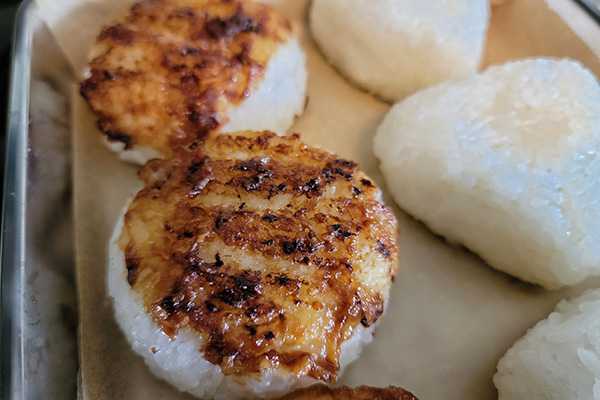
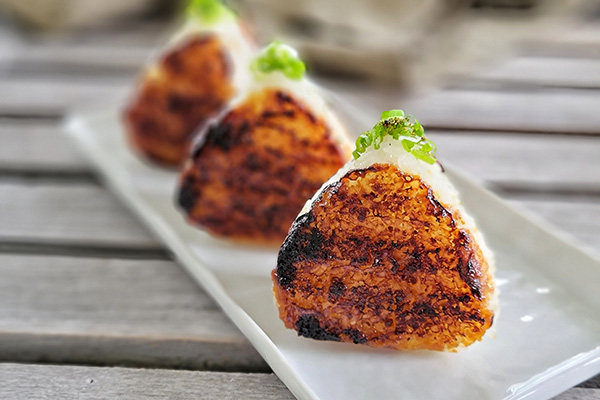
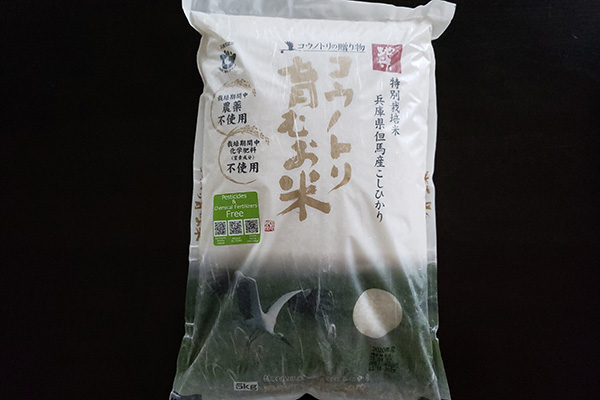



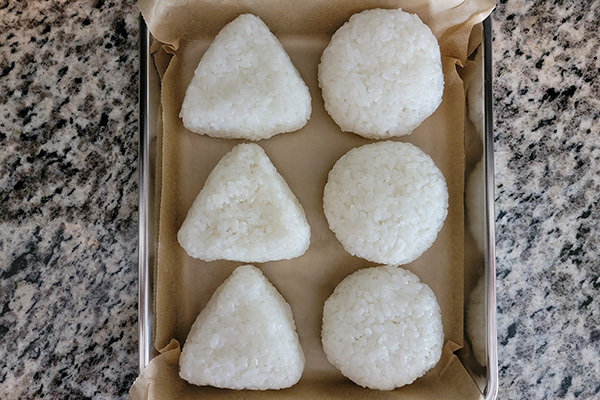
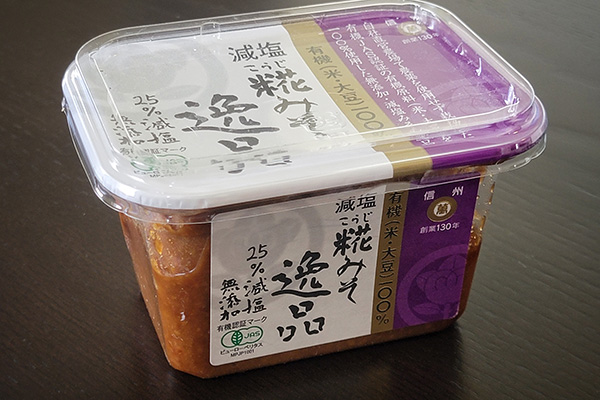
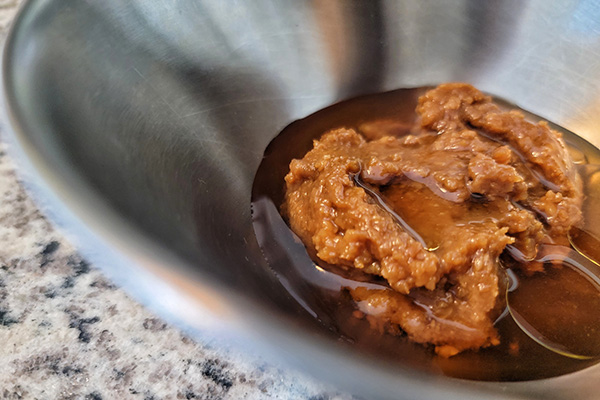
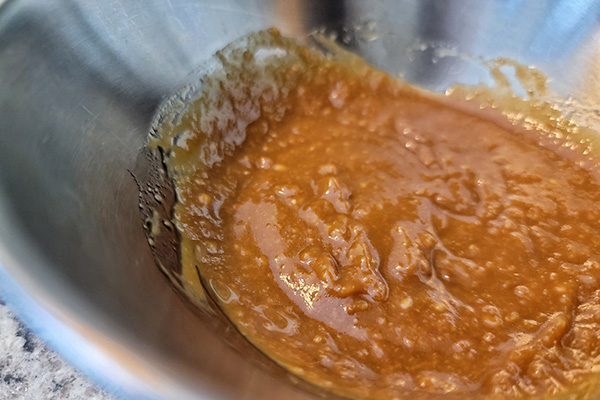
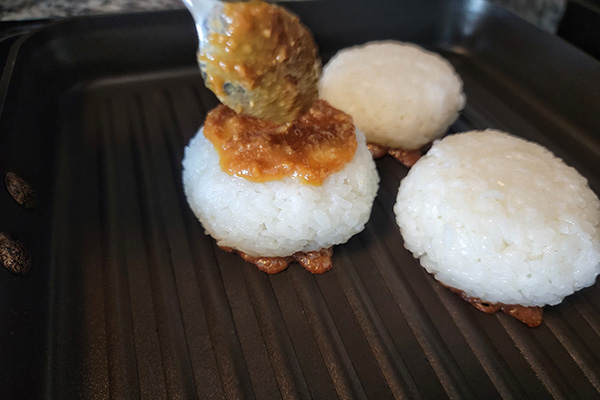


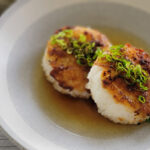
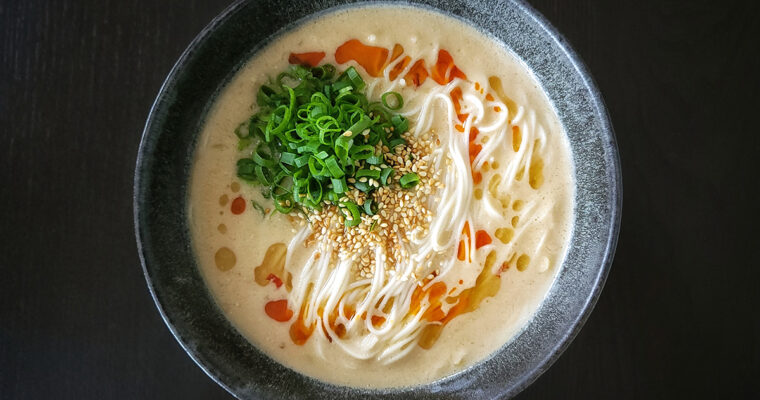
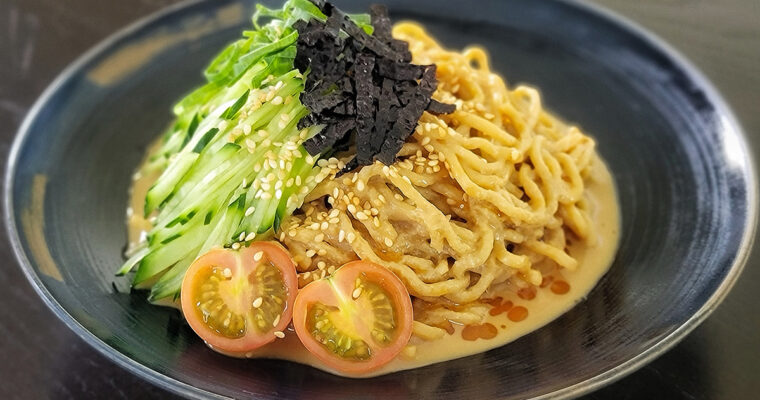



1 thought on “Miso Grilled Onigiri with Green Tea (Ochazuke Style)”